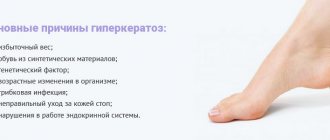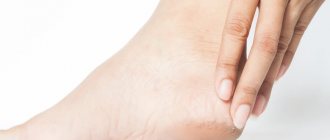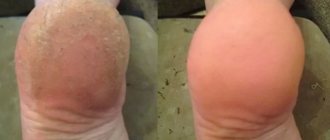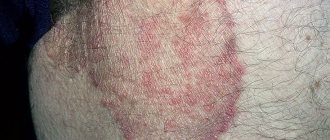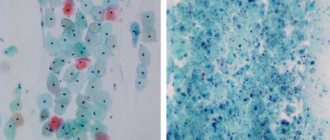Treatment of calluses and corns. Modern methods of therapy
Treatment of calluses is not the biggest problem of modern medicine.
But calluses cause inconvenience, and they just look ugly. Therefore, their competent removal determines the comfort of human life. Depending on the tissue structure, calluses are divided into:
- dry – normal roughening of the skin, without a cavity;
- aqueous - rubbed skin forms a cavity in which there is a colorless, watery, odorless liquid;
- blood - the same cavity, only with blood content;
- calluses with a core are the same dry calluses in which, due to constant irritation, a compaction has formed in the thickness of the tissue (core) in the same place.
Corns are diagnosed separately. The difference between them and calluses is that:
- they are usually smaller in size;
- “built” from a compacted center, around which there is a circular (circular) inflamed area of skin;
- painful even with slight pressure.
Removing corns, like calluses, is not a complicated procedure.
Water callus
In most cases, water callus treatment can be done independently. Small calluses are usually not painful and do not break open on their own. Therefore, they are simply covered with a plaster that protects them from injury. If the water callus is large, it causes significant discomfort and is fraught with rupture. It is better to pierce such a “dropsy”. The most favorable time for puncture is considered to be the first day after the bubble appears on the skin.
Piercing a water callus must be carried out with the obligatory observance of certain rules to avoid infection in the callus. First, it is necessary to disinfect the puncture site. To do this, lubricate the water callus with iodine or brilliant green. Secondly, the puncture can only be made with a sterile needle. You can take a regular pin or sewing needle. To sterilize it, you need to hold it in alcohol or heat it over a fire.
The puncture should be made on the side of the water callus, inserting the needle almost parallel to the surface of the skin. Under no circumstances should you pierce the callus perpendicular to its surface, as this will cause the needle to injure the bottom of the callus. To ensure that the fluid outflow from the water callus occurs continuously, it is better to make several punctures. The main thing is not to overdo it and preserve the walls of the bubble. Like a natural bandage, they cover the delicate skin located inside the water callus and protect it from damage and infection.
After the punctures are made, the water callus is gently pressed with a gauze cloth so that all the existing liquid comes out of it. If over time the callus becomes filled with contents again, it will be necessary to repeat the puncture. To prevent the development of infection after a puncture, an ointment containing an antibiotic is applied to the water callus. Then cover the callus with a protective plaster, which should be changed at least 2 times a day and removed at night.
If the opening of the water callus occurs spontaneously and with a tearing of its wall, the resulting wound must be cleaned and disinfected, apply antibacterial ointment and cover the callus with a gauze pad and adhesive tape. The latter will protect the water callus from contamination and injury, creating favorable conditions for its healing.
If an infection gets into a water callus, it is necessary to open it and remove the walls, since in a closed callus favorable conditions are created for the development of the infectious process and suppuration. Therefore, if infected, you should seek help from a surgeon. In compliance with all the rules of asepsis, he will perform an autopsy and initial treatment of the infected water callus, apply a bandage to ensure drainage of the wound and prescribe local antibacterial treatment.
Anatomical and physiological essence of calluses
To successfully treat calluses, you need to understand why they occur.
The skin is designed in such a way that it is not afraid of external irritants (chemical, mechanical, thermal). And thanks to the regular proliferation of cells, it is able to quickly regenerate (old cells are rejected, new ones appear in their place).
But with prolonged mechanical action, friction, pressure, excessive irritation, the skin becomes rough and calluses appear. Most often they are formed due to permanent friction on the hands and feet. Although calluses are often observed on the elbows, tongue, gums and even in such unusual places as the male penis, labia in women, nipples and areas of skin under the nails.
More information about what atypical places calluses can form and what this means for the patient can be found on the pages of our website https://www.dobrobut.com/. Also on the site you will find other useful information about calluses and corns.
Summer problem - calluses
14.06.2021
Calluses occur as a result of damage caused by pressure and friction of a foreign object on the skin. The skin in those places where excessive friction occurs becomes denser and rougher. But if this did not happen, bloody wounds would form on the skin. Most often, calluses appear in the heel and on the toes .
There are several types of calluses:
- dry calluses . They are formed by friction and look like a rough layer of skin. These calluses cause pain and there is a desire to get rid of them quickly. But it was not there! Dry calluses have their roots deep into the skin, so it is difficult to get rid of them;
- wet callus . It looks like a bubble filled with water. In fact, there is lymph fluid inside this bladder. It also occurs from friction. This damages the skin tissue. You will notice the appearance of such a callus She will make herself known to you with acute pain;
- bloody callus . if the vessels at the sites of damage are located close to the skin, then the wet callus becomes bloody. In this case, the bladder is filled not with lymph, but with blood ;
- Plantar calluses occur primarily on the balls of the feet. They are formed due to the constant pressure of body weight and the pressure of shoes.
How to deal with calluses that have formed?
A wet callus should not be covered with a regular band-aid. In this case, the wound will not heal. For these purposes, it is better to use a special bactericidal patch with a soft gauze pad. If a bubble with liquid is pierced, then it is necessary to treat the damaged area with some kind of antiseptic.
To get rid of dry calluses , you will have to work a little more. First you need to make sure that it is really a callus and not a wart, for example. A wart consists of living tissue and cannot be damaged. Cutting dry calluses is not recommended. Not only is this ineffective, since the callus may appear again, but an infection can also be caused.
How then can you get rid of calluses?
- Use special creams and ointments. These ointments contain salicylic acid and other auxiliary components that soften the skin. Before applying the ointment, you should steam your feet . The ointment must be left for 6 hours and then carefully removed with a scraper.
- Remove callus in the pedicure room. They use a special procedure using a boron installation.
- To remove old calluses with deep roots, laser and liquid nitrogen are used. callus removal is absolutely painless. With the help of a laser unit, the callus is burned completely, to the very end.
How to prevent the formation of calluses?
- Change your shoes throughout the day. When you get home, change into shoes that are comfortable for your feet . It’s better to go without it altogether.
- Excessive sweating of the feet can lead to excessive friction of shoes on the feet , and, as a result, the appearance of calluses .
- It is better to buy new shoes in the late afternoon, because at this time your feet swell a little. Shoes bought in the morning may not fit your feet in the evening.
Published in Surgery Premium Clinic
Treatment of calluses, basic methods
You can get rid of roughening (callus) of the skin in different ways. Treatment for calluses depends on their type and severity. In the arsenal of doctors are:
- therapy with medications that “dissolve” skin roughness;
- anti-callus patches;
- surgical removal (excision);
- The most modern method is laser removal of calluses.
Removing calluses using surgical instruments is performed not only by surgeons, but also by podiatrists - specialized specialists who deal exclusively with the feet.
Treatment of dry calluses on toes and hands
If such calluses have appeared recently, they do not need to be excised. There is every chance that such calluses can be removed by using gels and creams with keratolytic properties - that is, those that prevent changes in skin cells, which causes its roughening.
Some of the most effective ingredients of these ointments and gels are:
- salicylic acid;
- benzoic acid.
Treatment of dry calluses on the toes (feet) and hands (palm of the hands) may take longer than in other locations. The reason is that the skin here becomes calloused more intensely and to a greater depth. To be more effective, the removal of dry calluses on the feet and hands should be preceded by softening them (achieved by simple immersion in liquid).
Calluses on the feet
- The nail hurts
- Calluses
- Nail deformities
- Corns
- Ingrown nail
- Crack on the foot
- Nail fungus
- Diabetic foot
- The nail has turned yellow
- SMART pedicure
- Calluses
- On my feet
- Callosity
- Treatment
- Removal
Calluses on the feet occur due to wearing tight, uncomfortable shoes or due to the excessive tendency of the skin to become keratinized.
These small lumps can cause pain, making it difficult to walk. A callus is a dense, circumscribed formation of the stratum corneum of the skin that occurs in areas of the most constant friction or pressure. Over time, its color acquires a yellowish tint. They can be of different sizes. They can sometimes cause pain, especially if they are located in the deeper layers of the skin and affect nerve endings.
Classification
- dry calluses (differ in that they have a deeper localization and dense structure, and also most often form a “root” or “rod”);
- wet calluses (characterized by the accumulation of fluid and the formation of blisters, which must be treated with antibacterial agents and treated with healing ointments).
If this defect occurs, you should pay attention to your health, since there are some diseases of human organs and systems that are accompanied by the formation of calluses on the feet. For example, a hard callus on the edges of the heels confirms the presence of unfavorable changes in the joints. A callus that appears on the outer edge of the foot may indicate problems with the spine. If an unpleasant cosmetic defect spreads from the heel to the inside of the sole, this indicates a disruption of the intestines. A callus under the little toe of the left foot indicates a deterioration in heart function.
If the callus exists under the little toe of the right foot, this indicates a violation of the liver. If rough skin appears on the outer edges of the big toes, a malfunction of the thyroid gland can be suspected. If a person is overweight, this defect indicates a slowdown in metabolism, and if the person is underweight, it indicates that the patient has hyperthyroidism (excessive production of thyroid hormones). Violation of the function of the appendages in women, and in men the presence of the first signs of prostatitis, can provoke the formation of a callus on the convex joint of the big toe.
Photos "before" and "after"
In differential diagnosis in podology, calluses are distinguished from corns.
The formation of calluses on the feet can be avoided by wearing comfortable, quality shoes and preventing feet from getting wet by wearing dry, suitable socks. To prevent the formation of a cosmetic defect, it is recommended to use special adhesive plasters or silicone pads to reduce the pressure of shoes on the foot.
The prognosis for this process is favorable, subject to proper treatment of calluses and timely prevention.
Treatment of dry calluses with a rod
In this case, the surgical method is more effective, since it is technically impossible to lubricate the roughened core deep in the tissue with keratolytic ointments or gels in order to soften it.
Treatment of dry calluses with a core is a small surgical operation in compliance with the principles of asepsis, that is, with the treatment of the surgical field and the doctor’s gloves with antiseptics. Local anesthesia is mandatory, especially if the callus is old and it is assumed that the rod is deeply embedded.
Callus removal proceeds as follows:
- First, the callus itself is excised;
- Next, a neat incision is made in depth;
- Through it, the clamp grasps the rod and removes it.
It is easier to remove a callus on a toe with a rod than on the heel, because the length of the rod will not be long and the cut will not be deep.
Drug therapy for calluses
Treatment with medications is shown most effectively in the case of the formation of dry growths, as well as in the formation of calluses on a child’s foot.
Callus plasters are used, which have a keratolytic effect.
This method of therapy has a number of advantages:
- when using keratolytics, symptoms of discomfort are reduced
- the patch prevents infection
- accelerates the healing process of the skin
The pharmaceutical industry produces several types of patches.
Let's look at the commonly used ones:
- Salipod. The active ingredient included in this drug is salicylic acid. Under the influence of acid, dying epithelial cells dissolve, and the reproduction of healthy cells is activated. The patch is effective not only against corns, but also against growths with a shallow penetration rod.
- Mozolin. The substances contained in the patch soften rough skin. The soft layers of the growth begin to peel off and healthy tissue remains in place of the callus.
- Space. The product contains silicone. The drug has hypoallergenic properties, helps eliminate pain and stimulates regenerative processes. The patch is recommended for use by people with sensitive skin.
In addition to patches, preparations in the form of gels and ointments based on lactic or salicylic acids can be prescribed.
They effectively remove rough areas of skin.
For corns and dry growths, Bensalitin ointment can be used, acting as an antiseptic;
The disinfecting effect is expressed in Levomekol and Vishnevsky ointment.
Alkaline solutions: sodium hydroxide - promotes the dissolution of dead cells.
Soda baths have a similar effect.
Removing dry callus with a rod
With prolonged irritation of the skin, cell proliferation increases, which provokes thickening of the skin and contributes to the formation of a convex callus with a core.
Therapy for such growths is long-term.
When the convex part of the growth is cut off, it grows again.
Foot baths help remove dry growths on the legs.
The container is filled with hot water and mustard powder or soda is added to it.
After steaming the foot, the stratum corneum of cells can be easily removed.
Then the rod is treated with celandine juice.
This product should be used with great caution so as not to cause a burn to healthy skin.
The area prepared in this way is sealed with a “Salipod” plaster.
This manipulation usually takes a long time and you have to wait several days for the effect.
The problem can be solved much faster with the help of modern techniques for removing skin growths.
You should consult a doctor if some time has passed after the procedure and there is no result.
It is also necessary to urgently go to a specialist if an inflammatory process has developed in the area of the callus (the skin is inflamed and swollen, pus is released).
The doctor will treat the wound to stop the inflammatory reaction and also tell you what to do next.
Perhaps a specialist will prescribe the use of antibiotics.
The doctor will also need to differentiate dropsy caused by skin rubbing from Steven-Johnson syndrome.
The presence of watery blisters is caused by other reasons.
